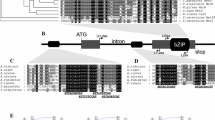Abstract
InAspergillus nidulans the positive-acting, wide domain regulatory geneareA mediates nitrogen metabolite repression. Previous analysis demonstrated that the C-terminal 153 residues of theareA product (AREA) are inessential for at least partial expression of most genes subject to regulation byareA. Paradoxically,areA r 2, a −1 frameshift replacing the wild-type 122 C-terminal residues with a mutant peptide of 117 amino acids, leads to general loss of function. To determine the basis for theareA r 2 mutant phenotype, and as a means of delineating functional domains within the C-terminal region of AREA, we have selected and characterisedareA r 2 revertants. Deletion analysis, utilising direct gene replacement, extended this analysis. A mutantareA product truncated immediately after the last residue of the highly conserved GATA (DNA-binding) domain retains partial function. TheareA r 2 product retains some function with respect to the expression ofuaZ (encoding urate oxidase) and the mutant allele is partially dominant with respect to nitrate reductase levels. Consistent with theareA r 2 product having a debilitating biological activity, we have demonstrated that a polypeptide containing both the wild-type DNA-binding domain and the mutant C-terminus of AREA2 is able to bind DNA in vitro but no longer shows specificity for GATA sequences.
Similar content being viewed by others
References
Arst HN Jr, Cove DJ (1973) Nitrogen metabolite repression inAspergillus nidulans. Mol Gen Genet 126:111–141
Arst HN Jr, MacDonald DW (1978) Reduced expression of a distal gene of the prn gene cluster in deletion mutants ofAspergillus nidulans: genetic evidence for a dicistronic messenger in an eukaryote. Mol Gen Genet 163:17–22
Arst HN Jr, Tollervey DW, Sealy-Lewis HM (1982) A possible regulatory gene for the molybdenum-containing cofactor inAspergillus nidulans. J Gen Microbiol 128:1083–1093
Berger G, Strauss J, Scazzocchi C, Lang BF (1991)nirA, the pathway-specific regulatory gene of nitrate assimilation inAspergillus nidulans, encodes a putative GAL4-type zinc finger protein and contains four introns in highly conserved regions. Mol Cell Biol 11:5746–5755
Caddick MX (1994) Nitrogen metabolite repression. Prog Ind Microbiol 29:323–353
Caddick MX, Peters DG, Platt AS (1994) Nitrogen regulation in fungi. Antonie Van Leewuenhoek 65:169–177
Clutterbuck AJ (1974)Aspergillus nidulans. In: King RC (ed) Handbook of genetics. Plenum Press, New York, pp 447–510
Clutterbuck AJ (1993)Aspergillus nidulans. In: O'Brian SJ (ed) Genetics maps. Locus maps of complex genomes, vol 3, 6th edn. Cold Spring Harbor Laboratory Press, Cold Spring Harbor, New York, pp 3.71–3.84
Crawford NM, Arst HN Jr (1993) The molecular genetics of nitrate assimilation in fungi and plants. Annu Rev Genet 27:115–146
Dang CV (1988) Detection and use of recombinant staphylococcal protein A fusion proteins to localize nucleic acid-binding domains. Anal Biochem 174:313–317
Drainas C, Kinghorn JR, Pateman JA (1977) Aspartic hydroxamate resistance and asparaginase regulation in the fungusAspergillus nidulans. J Gen Microbiol 98:493–501
Gorfinkiel L, Diallinas G, Scazzocchio C (1993) Sequence and regulation of theuapA gene, encoding a uric acid-xanthine permease in the fungusAspergillus nidulans. J Biol Chem 268:23376–23381
Gyllenstein UB, Erlich HA (1988) Generation of single stranded DNA by the polymerase chain reaction and its application to direct sequencing of the HLA-DQA locus. Proc Natl Acad Sci USA 85:7652–7656
Higuchi R (1990) Recombinant PCR. In: Innis MA, Gelfand DH, Sininsky JJ, White TJ (eds) PCR protocols: a guide to methods and applications. Academic Press, San Diego, pp 177–183
Kudla B, Caddick MX, Langdon T, Martinez-Rossi NM, Bennett CF, Sibley S, Davis RW, Arst HN Jr (1990) The regulatory geneareA mediating nitrogen metabolite repression inAspergillus nidulans. Mutations affecting specificity of gene activation alter a loop residue of a putative zinc finger. EMBO J 9:1355–1364
Langdon T, Sheerins A, Ravagnani A, Caddick MX, Arst HN Jr (1995) Mutational analysis reveals dispensability of the N-terminal region of theAspergillus nidulans transcription factor mediating nitrogen metabolite repression. Mol Microbiol 17:877–888
Merika M, Orkin SH (1993) DNA-binding specificity of GATA family transcription factors. Mol Cell Biol 13:3999–4010
Peters DG, Caddick MX (1994) Direct analysis of native and chimeric GATA specific DNA binding proteins fromAspergillus nidulans. Nucleic Acids Res 22:5164–5172
Platt A (1995) Identification of sequences in the regulatory geneareA responsible for modulating nitrogen metabolite repression inAspergillus nidulans. PhD thesis, University of Liverpool, UK
Pontecorvo G, Roper JA, Hemmons LM, Macdonald KD, Bufton AWJ (1953) The genetics ofAspergillus nidulans. Adv Genet 5:141–238
Ravagnani A, Arst HN Jr (1995) Quantitation of oligohistidine fusion proteins using63Ni+− chelation. Nucleic Acids Res 23:3069–3070
Saba S, Brickman JM, Lehming N, Ptashne M (1993) New eukaryotic transcriptional repressors. Nature 363:648–651
Scazzocchio C, Darlington AJ (1968) The induction and repression of the enzymes of purine breakdown inAspergillus nidulans. Biochim Biophys Acta 166:557–568
Shaffer PM, Arst HN Jr, Estberg L, Fernando L, Ly T, Sitter M (1988) An asparaginase ofAspergillus nidulans is subject to oxygen repression in addition to nitrogen metabolite repression. Mol Gen Genet 212:337–341
Stankovich M, Platt A, Caddick MX, Langdon T, Shaffer PM, Arst HN Jr (1993) C-terminal truncation of the transcriptional activator encoded byareA inAspergillus nidulans results in both loss-of-function and gain-of-function phenotypes. Mol Microbiol 7:81–87
Tilburn J, Sarkar S, Widdick DA, Espeso EA, Orejas M, Mungroo J, Penalva MA, Arst HN Jr (1995) TheAspergillus PacC zinc finger transcription factor mediates regulation of both acid- and alkaline-expressed genes by ambient pH. EMBO J 14:779–790
Author information
Authors and Affiliations
Additional information
Communicated by C. A. M. J. J. van den Hondel
Rights and permissions
About this article
Cite this article
Platt, A., Ravagnani, A., Arst, H. et al. Mutational analysis of the C-terminal region of AREA, the transcription factor mediating nitrogen metabolite repression inAspergillus nidulans . Molec. Gen. Genet. 250, 106–114 (1996). https://doi.org/10.1007/BF02191830
Received:
Accepted:
Issue Date:
DOI: https://doi.org/10.1007/BF02191830




